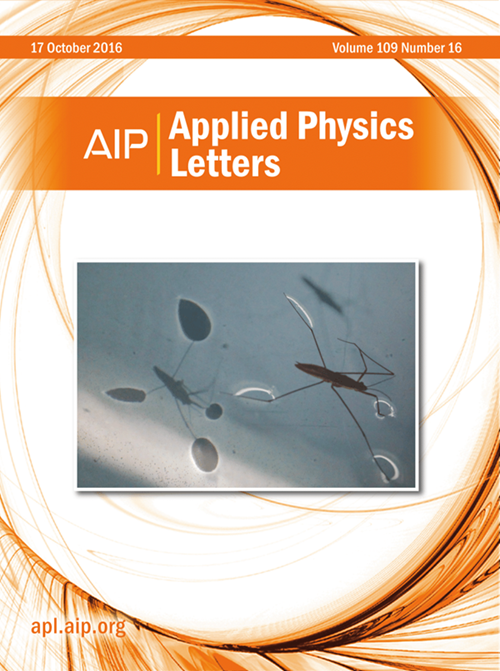Alloying-enhanced ferromagnetic coupling in two-dimensional transition metal carbide MC (M = Cr, Mn) monolayers
IF 3.5
2区 物理与天体物理
Q2 PHYSICS, APPLIED
引用次数: 0
Abstract
Two-dimensional (2D) intrinsic ferromagnetic materials with high ferromagnetic transition temperature (Tc) are critical to the advancement of spintronic device technology. In this study, we present two stable room-temperature ferromagnetic carbides, namely, MC (M = Cr, Mn) monolayers, with Tc values of 384 and 391 K, respectively, along with strong perpendicular magnetic anisotropy (PMA). Furthermore, CrxMn8−xC8 (x=1–7) alloy monolayers are constructed. We demonstrate that the appropriate incorporation of Cr–Mn atomic pairs substantially enhances the ferromagnetic coupling, which is intimately associated with the interactions between metal atoms and their spatial arrangements within the lattice. In particular, the CrMnC2 alloy monolayer exhibits a Tc of 627 K, markedly exceeding that of the parent monolayer. This elevated Tc is attributed to the combined effect of the crystal-field energy difference introduced by the alloying process and the internal stresses arising from the lattice distortion induced by alloying, which jointly enhance ferromagnetic interactions. In addition, CrMnC2 exhibits robust PMA, in-plane magnetic anisotropy induced by structural asymmetry, and slight ferroelastic behavior. These findings offer insights on the impact of alloy engineering on 2D ferromagnetism and highlight a pathway toward high-Tc 2D ferromagnetic materials for practical room-temperature device applications.二维过渡金属碳化物MC (M = Cr, Mn)单层中合金增强的铁磁耦合
具有高铁磁转变温度(Tc)的二维本征铁磁材料对自旋电子器件技术的发展至关重要。在本研究中,我们制备了两种稳定的室温铁磁碳化物,即MC (M = Cr, Mn)单层,其Tc值分别为384和391 K,并具有很强的垂直磁各向异性(PMA)。进一步,构建了CrxMn8−xC8 (x= 1-7)合金单层。我们证明了适当的Cr-Mn原子对的结合大大增强了铁磁耦合,这与金属原子之间的相互作用及其在晶格内的空间排列密切相关。其中,CrMnC2合金单层的Tc值为627 K,明显高于母层。这是由于合金化过程中引入的晶体场能量差和合金化引起的晶格畸变引起的内应力共同增强了铁磁相互作用的结果。此外,CrMnC2具有强大的PMA,结构不对称引起的面内磁各向异性和轻微的铁弹性行为。这些发现为合金工程对二维铁磁性的影响提供了见解,并突出了用于实际室温器件应用的高tc二维铁磁性材料的途径。
本文章由计算机程序翻译,如有差异,请以英文原文为准。
求助全文
约1分钟内获得全文
求助全文
来源期刊

Applied Physics Letters
物理-物理:应用
CiteScore
6.40
自引率
10.00%
发文量
1821
审稿时长
1.6 months
期刊介绍:
Applied Physics Letters (APL) features concise, up-to-date reports on significant new findings in applied physics. Emphasizing rapid dissemination of key data and new physical insights, APL offers prompt publication of new experimental and theoretical papers reporting applications of physics phenomena to all branches of science, engineering, and modern technology.
In addition to regular articles, the journal also publishes invited Fast Track, Perspectives, and in-depth Editorials which report on cutting-edge areas in applied physics.
APL Perspectives are forward-looking invited letters which highlight recent developments or discoveries. Emphasis is placed on very recent developments, potentially disruptive technologies, open questions and possible solutions. They also include a mini-roadmap detailing where the community should direct efforts in order for the phenomena to be viable for application and the challenges associated with meeting that performance threshold. Perspectives are characterized by personal viewpoints and opinions of recognized experts in the field.
Fast Track articles are invited original research articles that report results that are particularly novel and important or provide a significant advancement in an emerging field. Because of the urgency and scientific importance of the work, the peer review process is accelerated. If, during the review process, it becomes apparent that the paper does not meet the Fast Track criterion, it is returned to a normal track.
 求助内容:
求助内容: 应助结果提醒方式:
应助结果提醒方式:


